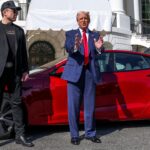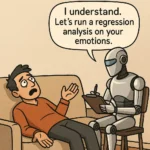
The humanoid robot is a fascinating scientific innovation with the machine looking just like the human body in shape, while performing functional purposes like the interaction with human tools and environments for experimental and real life purposes.
A humanoid robot is normally laced with a torso, a head, two arms, and two legs, but some of them may have just the waist up.
Tesla has in recent times, become one of the big tech companies at the fore front of the humanoid robots and on Friday, CEO Elon Musk showed off a prototype of the ‘Optimus’ humanoid robot developed by the company.
Musk, while unveiling the Tesla Bot shuffling across a stage, waving and pumping its arms in a low-speed dance move predicted that his company would be able to produce millions of them, while it sells the for $20,000 within three to five years.
According to Musk, Tesla would within three to five years be ready to take orders for the robot, even as he described the electric vehicle company move to develop Optimus over a decade or more.
“Our goal is to make a useful humanoid robot as quickly as possible,” Musk said. It could eventually “help millions of people,” but the first uses will be in Tesla’s car factories, he said.
The move by Tesla to design and build mass-market robots that would be tested in its factories is indicative of the company’s standout form other humanoid robots manufacturers.
At an event designed to showcase the robot and the company’s autonomous vehicle technology, called Full Self-Driving, or FSD, Musk had quipped that “The robot can do a lot more than what we showed you. We just didn’t want it to fall on its face,” an indication that there is certainly more in the offing.
The much anticipated unveiling of prototype robots at the company’s Palo Alto, California office can be adjudged to be part of Musk’s claim of Tesla’s lead in the field of Artificial Intelligence, earlier averring that it is not just a platform that makes “cool cars.”
Tesla had shown a video of an experimental test robot developed in January, walking out, while waving to the crowd as well as performing simple tasks like watering plants, carrying boxes and lifting metal bars at a production station at its California plant.
But the company further rolled to the platform a more streamlined current one that did a slow wave to the crowd, with Musk positing that it was closer to what he had hoped to put into production. Musk further said the ‘Optimus’ would be able to walk in a few weeks.
“There’s still a lot of work to be done to refine Optimus and prove it,” Musk said, adding later, “I think Optimus is going to be incredible in five or 10 years, like mind blowing.”
According to him, unlike existing humanoid robots who are “missing a brain” and the capacity to solve problems on their own, Optimus would be an “extremely capable robot” that Tesla would aim to produce in the millions.
Tesla is not the only car maker investing in humanoid robots, as other automakers like Toyota Motor (7203.T) and Honda Motor (7267.T), have in the past developed humanoid robot prototypes that can perform complicated functions like shooting a basketball, and production robots from ABB, but Tesla can be said to stand out as a company pushing the market opportunity for a mass-market robot that could also be used in factory work.
“We are trying to follow the goal of fastest path to a useful robot that can be made at volume,” Musk said.
Tesla, by developing a robotics business, Musk said, Twill be shifting the terms of a well-known mission statement that has become part of its appeal to investors and climate activists by committing to “accelerate the world’s transition to sustainable energy.”
“Optimus is not directly in line with accelerating sustainable energy,” Musk said. “I think the mission does somewhat broaden with the advent of Optimus to – you know, I don’t know: making the future awesome.”
The unveiling of the ‘Optimus’ prototype is not without mixed reviews just like other AI materials in the past but Musk who has previously highlighted the risks of artificial intelligence, said the mass rollout of robots had the potential to “transform civilization” and create “a future of abundance, a future of no poverty.” But he said he believed it was important that Tesla shareholders had a role in vetting the company’s efforts.
“If I go crazy, you can fire me,” Musk said. “This is important.”
Some of the feedbacks were positive as many Tweeps praised the speed of Tesla’s development effort since August 2021 that the company announced its project with a stunt that had a person in a white suit simulate a humanoid robot.
According to Henri Ben Amor, a robotics professor at Arizona State University, the $20,000 price target by Elon Musk was a “good proposition,” since current costs are about $100,000 for humanoid robots.
“There’s some discrepancy between sort of the ambition and what they have presented,” he said. “When it comes to dexterity, speed, the ability to walk in a stable fashion and so on, there’s still a lot of work to be done.”
A mechanical engineering professor at Carnegie Mellon University, Aaron Johnson however averred that the robot’s need was debatable.
“What is really impressive is that they got to that level so quickly. What is still a little murky is what exactly the use case is for them to make millions of these,” Johnson said.
Discover more from TechBooky
Subscribe to get the latest posts sent to your email.






